Archives
17 December, 2015

The portraits of Dharmendra Patel
It’s only about 10 metres’ walk from the door of the Heritage Gallery in the Old Royal Naval College at Greenwich to the lecture room at its far end but, in the spring of this year, for the time it took you to cross the floor you would have been unable to avoid the image of a man crouched on the ground beside a radiator in front of you. This is ‘Yasser’, Dharmendra Patel’s stunning photograph of a Sudanese man painfully and emotionally stranded between the country in which he has been granted asylum status and the country he is still scared he will be sent back to.
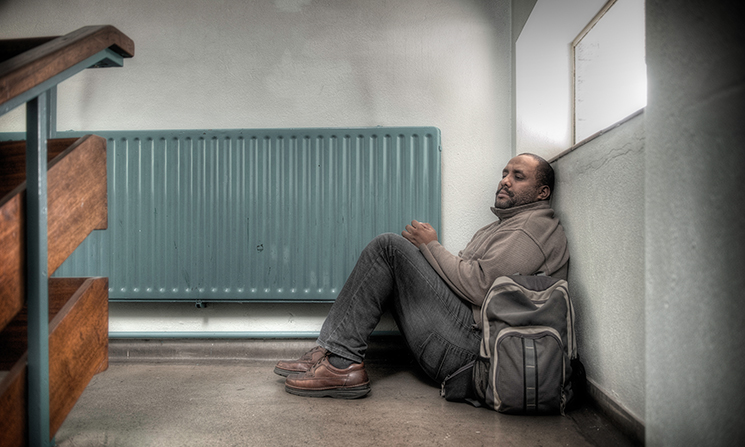
Yasser – Birmingham, 2010 © Dharmendra Patel. Dharmendra’s full caption to the photograph is given at the end of this blog.
In the Heritage Gallery, where photographs from our 100 Images of Migration were on display, ‘Yasser’ was huge: literally, in a print (courtesy of the University of Leicester School of Museum Studies) measuring 3.5 metres wide and just over 2 metres high; but also metaphorically, in the mesmeric power it had to draw people into the space. Visitors sheltering from the rain in Queen Anne Court would see the picture and find themselves drawn into the room to look at it more closely. It was always one of the photos that received the most mentions in visitors’ comments.
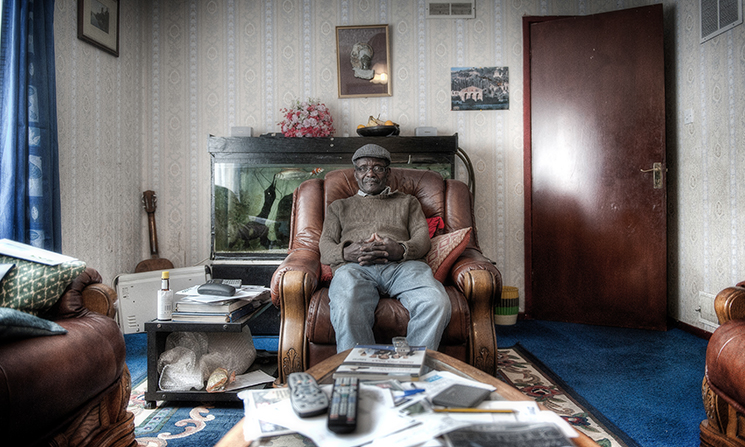
Pastor Reynolds – Birmingham, 2010 © Dharmendra Patel. Dharmendra’s full caption to the photograph is given at the end of this blog.
On the adjacent wall there was another portrait, less harrowing and smaller in scale, but quietly powerful nonetheless. This was ‘Pastor Reynolds’, another photograph by Dharmendra, this time of an old man sitting in a (clearly) favourite armchair, surrounded by the bric-à-brac of his life, and looking into the camera with a gently contented smile.
Not exactly polar opposites, ‘Pastor Reynolds’ and ‘Yasser’ nevertheless epitomised the range of experience 100 Images of Migration set out to convey. Each packs a huge punch; each comes across as entirely natural – a life captured in an image – even though its artifice is plain to see. These are posed photographs, but photographs of rare depth and clear engagement between photographer and subject.
Dharmendra Patel is waiting for me at the railway station of Sandwell & Dudley, but I walk straight past him, embarrassingly because I am looking for a woman: Dharmendra signs himself ‘Dee’ on his e-mails, in wry recognition of the difficulty people who are not of Indian origin have in pronouncing his name – and the only ‘Dee’s I have met previously have been female. Dharmendra takes the confusion with good grace (good grace is clearly something he was born with) and we joke about it as he drives us to the municipal office where we are going to talk – and about the Chelsea footballer Azpilicueta, who was called ‘Dave’ by fans and players because they found his name too difficult; and how many British Asians get called by their family names, which are considered easier to pronounce than their first names. The embarrassment passes – and it was all on my side in any case.
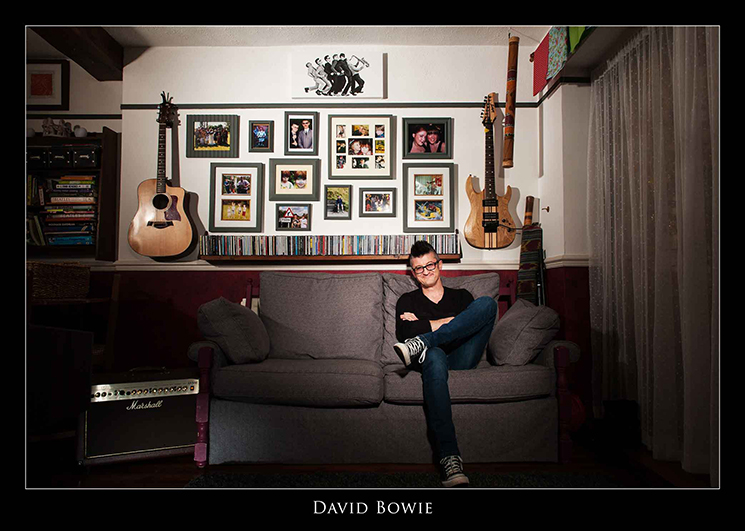
Spoz; the first of four ‘Couch Stories’ portraits featured here. Each person was asked who they would like to be sitting alongside them on the couch or sofa, and their answer is given in capitals at the base of the photograph. Spoz is a former laureate from Birmingham, who enjoys listening to and playing music. © Dharmendra Patel
Dharmendra describes himself as an environmental portrait photographer. It’s the Ronseal description of what he does, which is to photograph portraits of people in their own environment. Both ‘Yasser’ and ‘Pastor Reynolds’ are examples of this approach, though they were in fact part of an earlier project, Land of Hope and Glory, which you can see on Dharmendra’s website – and for which he has written an introduction that I urge you to read: in a few hundred words it says more about migration in this country than I have read in articles ten times its length. It says so much about the man, too: his easy grace, his self-deprecating character, his excitement at having stumbled on something that he recognises to be so powerful.
For Dharmendra did stumble upon photography. He had always enjoyed photography, and done it, but it is only recently that he has practised it professionally. Before 2010 he worked in the clothing industry, having graduated from De Montfort University with a degree in business management and marketing. The change came, first, in 2008, when he bought a digital camera, and two years later, in 2010, when he was one of 15 people from different artistic backgrounds accepted onto a professional development programme. For Dharmendra this led to Land of Hope and Glory, a project in which he was, as he puts it, heavily mentored by Vanley Burke, the great photographic chronicler of the black community in Birmingham and Handsworth.
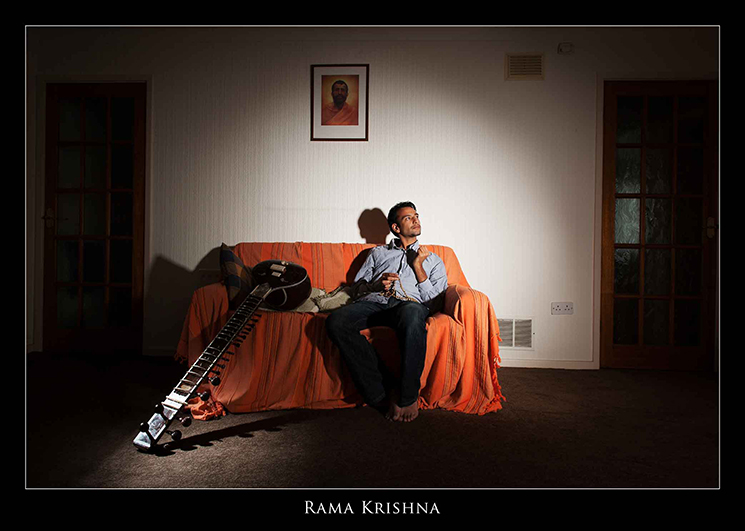
Rohit, a call-centre manager from Birmingham, is a sitar player and spoken-word poet. © Dharmendra Patel
Professional since 2011, Dharmendra has honed his portraiture skills over the course of the years, tracking down the photographers of images he loves and asking for their secrets, especially their tips on lighting (two strobes and a hot-shoe flash, all off camera, for any technophile who might be reading this). More recent projects – especially his Couch Stories, the source of most of the other photographs on this blog – show how much he has refined his technique. He is meticulous about setting up his portraits but candid about the fact that many of his best photos have been taken when he’s pretending to set the lighting up and when the conversation has just reached a point where there is an obviously natural connection between photographer and subject. His photographs are joyful, even when they tell painful stories, because of the clear empathy he has for his subjects. Human warmth courses through the celluloid. And through what he says, whether it’s in print or in person. To go back to ‘Yasser’ and ‘Pastor Reynolds’, these are powerful photographs in their own right, but they are doubly so when they are viewed alongside the text that Dharmendra has written about them.
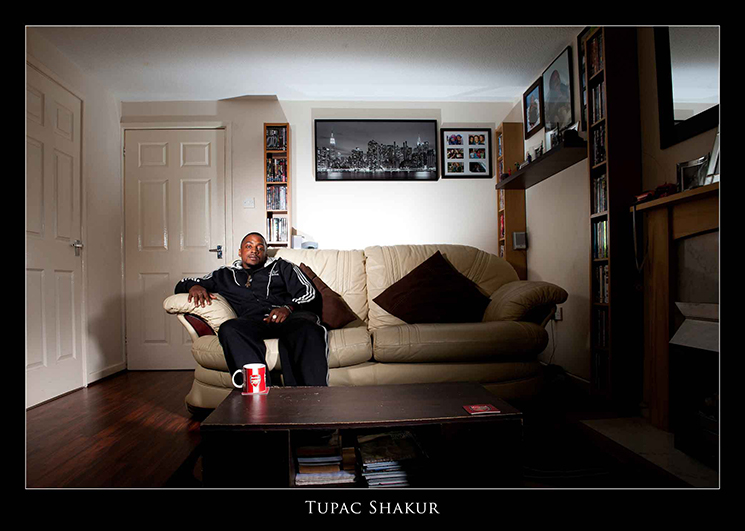
Fab, a videographer and actor based in Birmingham, starred in a play at the RSC in Stratford. © Dharmendra Patel
His parents (she from Kenya, he from India) moved to this country in the late 1960s, and he grew up and went to school in Leicester, in a predominantly white neighbourhood where he got used to the predictable, if off-target, taunts of ‘Here come the Pakis’ (as a quiet act of vengeance he relished his schoolmates’ inability to distinguish between people of Indian and Pakistani heritage). Dharmendra is aware that some people claim never to have experienced racism – but he did, and it was something that came between him and his father, who (in a way typical of a first-generation migrant) preferred not to hear the racial abuse that the two of them experienced on the street. When he walks down the street with his own daughter now, Dharmendra wonders how he would respond to similar taunting – but it’s clear to both of us that he wouldn’t allow it, more importantly that he wouldn’t allow his daughter to believe people should be able to get away with that kind of abuse.
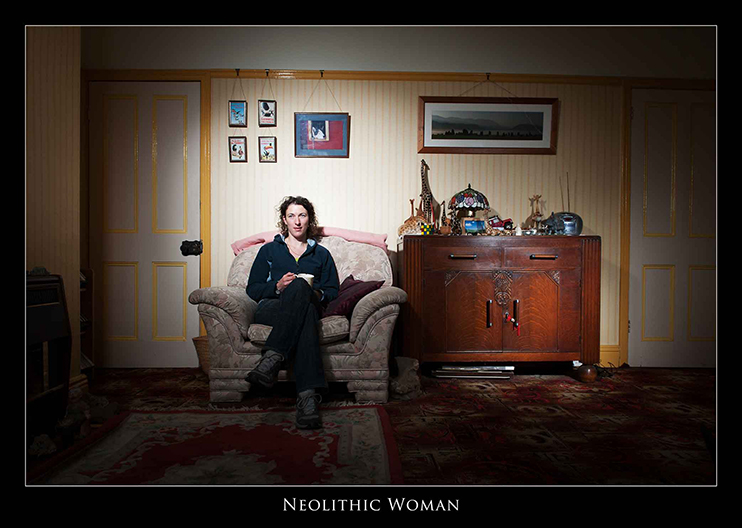
Louise, one of Yorkshire’s first female dry stone wallers, enjoys hiking and wild camping; she also teaches chainsaw and tree-felling courses. © Dharmendra Patel
Born and bred in Britain, Dharmendra always identified as British, but it wasn’t until he visited his father in India, who had just had a heart attack on a visit to his home village, that he had a recognition of stark clarity that ‘This was where I am from’. Since then, he has thought more about his extended family, his father and mother’s backgrounds, and the country of their origin. We talk about how it is feasible to have multiple loyalties and identities, and I sense that this lies at the heart of many of Dharmendra’s photographs: talking to people about where they belong, where they feel most comfortable, where they’re at home. On one level it’s a small project he has taken on, an exercise in miniatures, but it’s one that he has transmuted into something grander, something magical.
And it’s not entirely magical, but I like the story of how he met his wife, who was living in Walsall at the time, where Dharmendra had moved in 2002. Near enough to be almost neighbours, they actually met in India, where the two of them were attending the grand opening of the recently refurbished village temple of which Dharmendra’s grandfather was the priest – it turns out that their fathers knew each other. It’s a doubly sweet coincidence because the meeting of course led to their wedding, and the one aspect of Dharmendra’s professional life that he finds the least stimulating is wedding photographs, the staple diet of many a photographer.
I’d worried, when booking train tickets to meet him, that I’d left far too long between trains and that I’d have to invent some other engagement to go to when conversation ran dry. I needn’t have: we talk so long that we lose the chance to have lunch and missing my train back also begins to look a real possibility. ‘It’s all to do with stories,’ Dharmendra says about his photographs. ‘The images are just a door opening onto a life.’ I think about the phrase on the train back to London, how close it is to our own strapline of ‘All Our Stories’ – and I understand again the power of ‘Yasser’ and ‘Pastor Reynolds’ to move people.
Dharmendra’s full captions to ‘Yasser’ and ‘Pastor Reynolds’
‘Yasser’ – Yasser was brought up in a rural district near Khartoum. Growing up was hard – “Human rights are like the lottery in Sudan: some get it, some don’t.”
He fled his country at the age of 28 after being imprisoned and tortured by the Sudanese State; leaving his mother and younger sister behind, he came to England. He had very little money and no contacts here. He was granted asylum in 2005. He loves the UK but, even though he has asylum status, he is scared to call on the authorities such as the police or the ambulance in case he is sent back to Sudan.
I decided to take the picture the way I did because it shows how he was feeling. It made me realise how much I was taking life for granted. I am the same age as this man, and his upbringing and mine were vastly different.
‘Pastor Reynolds’ – Pastor Reynolds was born in 1929 and came to England on 15 March 1960. It was difficult leaving his family and friends for a new land of opportunity and promises. Uncertainty got the better of him and he spent his last few moments in Jamaica contemplating what he was going to leave behind. This was the first time he had travelled out of his country. When he landed, the cold hit him and he spent the first few days battling homesickness.
Pastor Reynolds spent 20 years working on the railways of Birmingham and for a large engineering company before becoming a pastor.
The image was taken at the Pastor’s home in Birmingham. I decided to take the picture there because it was a reflection of his personality: relaxed and easy-going. He’s now retired and spends a lot of his time at the church and watching his children and grandchildren grow up.
Dharmendra Patel’s photographs are on display on his website: www.outroslide.co.uk His Twitter feed is @outroslide
14 December, 2015

Mihir Bose, one of our distinguished friends, argues in this guest blog that Europe will need to think outside the box if it is to cope with the most unique migrant crisis in its history – and he looks back to 1971 and the painful birth of Bangladesh for a telling point of comparison.
The migrant crisis that has engulfed Europe has seen a whole range of responses, from Angela Merkel’s August Wilkommenskultur – although that is fraying a bit now that summer has turned to winter – to the stated willingness of those on the European far right to let the refugee boats sink in the Mediterranean. One thing everyone in Europe is agreed on, however: this is the worst migration crisis the continent has seen since the end of the Second World War.
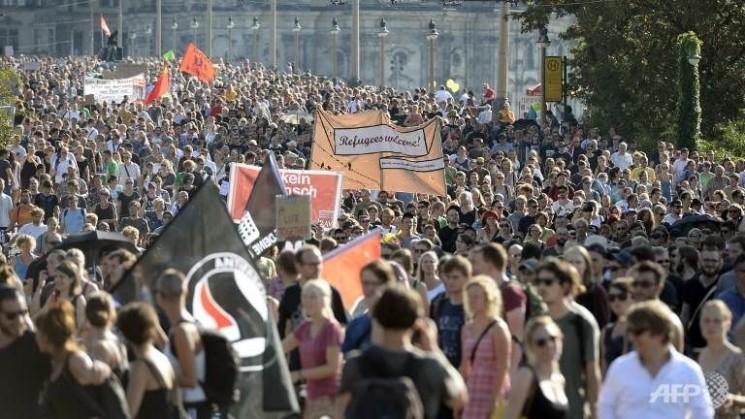
Anti-racism protesters rally in August in Dresden, stronghold of the anti-Islam PEGIDA movement. Activists demonstrate in solidarity with migrants, in a show of defiance against far-right extremists who have mounted protests against the influx of migrants to Germany. (AFP/Robert Michael)
In terms of size and scale it certainly is, but the fundamental nature of this migration is very different. Europe has never experienced migration of this nature, or at least not for over a thousand years, and we need to understand how different this migration is, because failure to do so has distorted the migration debate and is the reason why Europe is yet to develop a humane, viable, migration policy.
What makes this migration crisis different is that it is seeing people coming to Europe from other continents – Asia and Africa – whereas the Second World War refugee crisis was a purely European migration. At that time one of the biggest movements was 10 million Germans fleeing from the German provinces east of the Oder–Neisse line and from Czechoslovakia and Hungary to the western part of Germany then controlled by the three victorious Allies: Britain, France and the United States. This movement of the Volksdeutsche, ethnic Germans, marked the end of a forward-to-east, backwards-to-west movement which had been going on for almost a decade. These Germans had been living in Eastern Europe since about the 13th century. Hitler’s Nazi regime evacuated them to Germany between 1939 and 1940, only for them to be resettled, after Hitler had conquered Poland, in the newly conquered land – before they were forced back west, once again, after Poland was liberated by Soviet forces. The other movements of people were also Europeans – Poles, Ukrainians and Latvians – moving from one part of Europe to another.
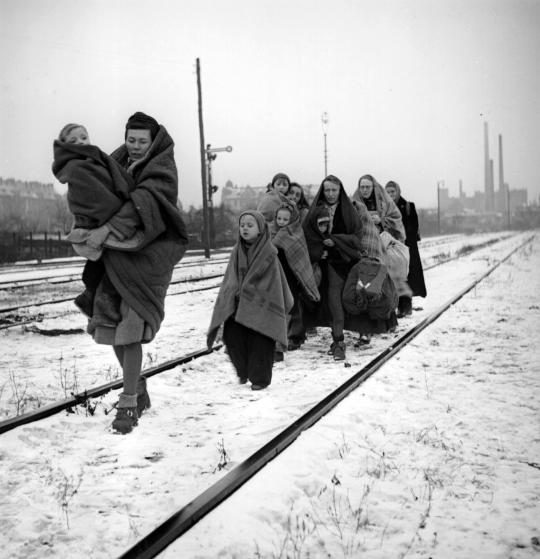
In 1945, a handful of survivors remain of the 150 refugees who left Lodz in Poland two months earlier, headed for Berlin. They follow railway lines in the hope of being picked up by a British train. © Fred Ramage
There was also the migration of many thousands of Jews, survivors of the Holocaust, for whom Europe had become a slaughterhouse. This was an intercontinental movement – but it was Europeans moving to Asia, not the other way round, which is the current position. In that sense this was part of the migration from Europe, involving millions of people, that had been going on for almost four centuries as the Europeans built their vast colonial empires and populated various continents. Indeed, even after the Jewish state was created in Palestine, this European migration to other lands carried on for two – almost three – decades after the war. This period saw Australia, under its White Australia policy, welcoming many Europeans and in the process making Melbourne the biggest Greek city after Athens and Thessaloniki. In Britain this was known as the £10 Pom policy: for £10 the British could migrate to Australia, provided they were white. This would see some famous migrants, including fast bowler Harold Larwood – who had so terrorised Australian batsman on the bodyline tour of 1932–33 that it had nearly led to Australia quitting the British Empire. Unhappy in England, he was now welcomed under the £10 policy and lived there for the rest of his life. And it is worth recalling that the iconic post-war film, Brief Encounter, made in 1945, concerning an affair between a married woman and a doctor, ends with the doctor emigrating to South Africa. The fact is Europeans were still leaving this continent in vast numbers after the war, and continued to do so for many decades.
Today’s migration not only reverses that flow but brings people with very different religions and cultures to Europe. For all the differences between Germans and Poles, it cannot be argued that they match the differences in culture and religion between modern Europeans and the refugees from Syria and other parts of Asia and Africa. In that sense, Europe has not seen such migration for over a thousand years, when, as historians tell us, the arrival of Islam in the Indian subcontinent triggered a westward movement of people from that part of the world, resulting in the formation of the gypsy communities in the west.
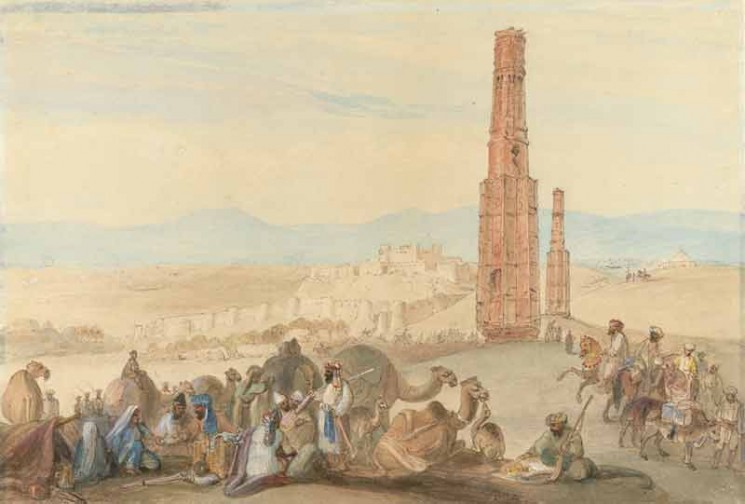
In the reign of Muhammad Ghor (1149–1206), Muslims extended their reach into what we now call India. This is a painting depicting a scene from that era.
The other big difference between the migration we are seeing now and that following the Second World War is that in 1945 the movement of people began only after Europe was once again at peace. The migration we are coping with currently is coming even as the war in Syria still rages, with not only no conclusion in sight but no agreement as to what that solution might be. In that sense, what we are facing is more like what happened in East Pakistan, now Bangladesh. Indeed, the similarities between Syria and events in east Pakistan are so striking that it is surprising western policy makers or opinion formers have not commented on them so far.
Today the Bangladesh genocide of 1971 is little remembered, although it was almost as horrendous as that of Rwanda. Let us recall it, because it may provide some lessons for Syria.
Like Syria, which was artificially constructed after the First World War, the Pakistan that emerged as a result of the British withdrawal from India in 1947 was a somewhat unnatural state. It was meant to be a home for the Muslims of the subcontinent but culturally there were vast differences between the Punjabi Muslims of West Pakistan and the Bengali Muslims in the east. As the events of 1971 proved, religion could not overcome these cultural differences – and matters were not helped by the fact that the two halves were separated by 1,000 miles of Indian territory, which made no secret that it did not want Pakistan to exist at all.
In 1970 the Avami League, dominated by the Bengalis in East Pakistan, won the country’s first truly democratic election. The outraged Punjabis of West Pakistan, who had ruled the country since its birth in 1947, unleashed a brutal crackdown, killing a quarter of a million Bengalis – maybe as many as a million – with 10 million refugees fleeing to neighbouring India, and thousands of women being raped. There was also a ferocious ethnic cleansing of the minority Hindu population of East Pakistan.
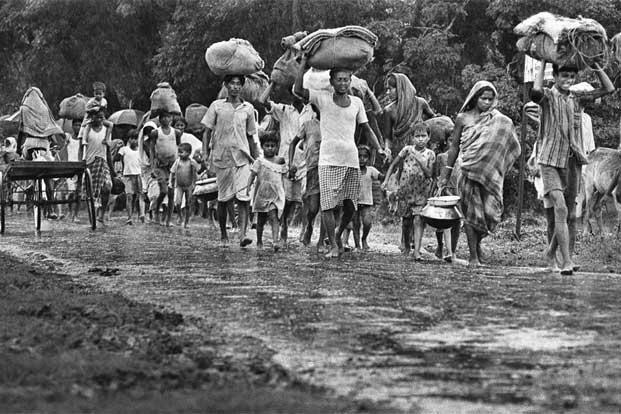
Refugees fleeing East Pakistan (shortly to become Bangladesh) into India at the time of the war of independence, 1970.
The Museum of Independence in Dhaka, which has evidence of Pakistani brutality, is one of the most chilling museums I have ever been to. As this blog is being written, Bangladesh is holding war crimes trials for those of its citizens who helped the Pakistanis in their genocidal activities – 45 years after the events in question took place there is no closure, and the trials hugely anger Pakistan, which refuses to accept what happened and still presents the break-up of Pakistan as the result of Indian machinations.
India’s intervention in the final month of the nine-month conflict was triggered by a Pakistani attack on its territory, though some have suggested that it might also have been influenced by the cost of supporting so many refugees from East Pakistan. Within weeks of its involvement, the war was over and most, if not all, of the 10 million refugees that had flooded into India at the start of the war went back to the newly created Bangladesh.
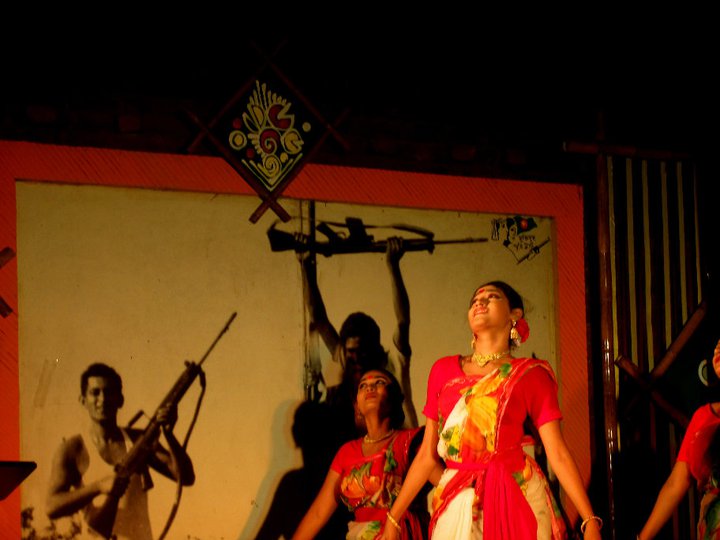
An Independence Day celebration held at the Museum of Independence in Dhaka.
Despite the scale of the 1971 migration crisis, one crucial difference between it and today’s Syrian-derived crisis is that the East Pakistani refugees had much in common with their Indian counterparts in west Bengal. In today’s migration crisis, there is no neighbouring country that can play the role India did then: Jordan, which has borne the burden of the refugees, is incapable of such a role; and Egypt, with which Syria had a union when President Nasser ruled Egypt and which, as the greatest Arab country, would have been ideally suited to play the role of India in this crisis, is so consumed by its own problems that it cannot even conceive such a thing.
So what does all this amount to? It means there can and will not be an easy solution to the Syrian crisis that lies at the root of Europe’s migration problem – and to go on drawing parallels with the Second World War refugee crisis means ignoring how much more complex this crisis is. We must also consider that for all the humanitarian motives of western statesmen, most notably Merkel, integrating very different communities is never easy. Even after 1,000 years the gypsy community remains a very distinct community in Europe, often distrusted, if not hated, by the majority community in many European lands – and one that Hitler tried to destroy.
This does not mean the refugee crisis cannot be solved – but it needs to be tackled along very different lines, or we are building false scenarios, with potentially worrying knock-on effects. As the security forces in France and Belgium come to grips with the dreadful terrorist attack on Paris, one of the most chilling discoveries has been that a passport of a Syrian refugee was found near the body of a dead suicide bomber. Although this was later discovered to be a fake, the inevitable conclusion people rushed to was that ISIS jihadists were infiltrating the refugees pouring into Europe and that therefore all such refugees were suspect and must be kept out. There is no proof that the Paris bombers were Syrian refugees – not even one of them – but it is a temping conclusion to jump to given how little we have considered the unique nature of this refugee crisis and how it requires Europe to think of solutions that are outside the box. It should not be beyond Europe’s powers to devise such solutions, but it cannot be done if we go on comparing this to the refugee crisis after the Second World War merely because the numbers are the same.
Mihir Bose is a journalist and author, and a distinguished friend of the Migration Museum Project. His latest book, From Midnight to Glorious Morning: A Look at India Since 1947, will be published in the new year by Vikas. You can read more about him on his website and follow him on Twitter: @mihirbose
6 November, 2015

A weird coincidence occurs shortly after Colin O’Brien and I sit down for a coffee in Hackney PictureHouse, just across the road from where his photos formed part of the Migration Museum Museum’s first exhibition of 100 Images of Migration at Hackney Museum. A young man, George Nelson, sits down at our table and, spying the books Colin has laid out in front of us, apologises for intruding on our conversation – but he has to show us the image he has open on his phone. It’s the front cover of Colin’s book, Travellers’ Children in London Fields, which George (a photographer himself, it emerges) has just been recommending to a contact. There follows a conversation in which George expresses his admiration for Colin’s work, and Colin, generous and courteous as ever, asks questions about George’s work. Throughout it all, Colin seems completely unfazed by the coincidence or the praise, making no big deal about either.
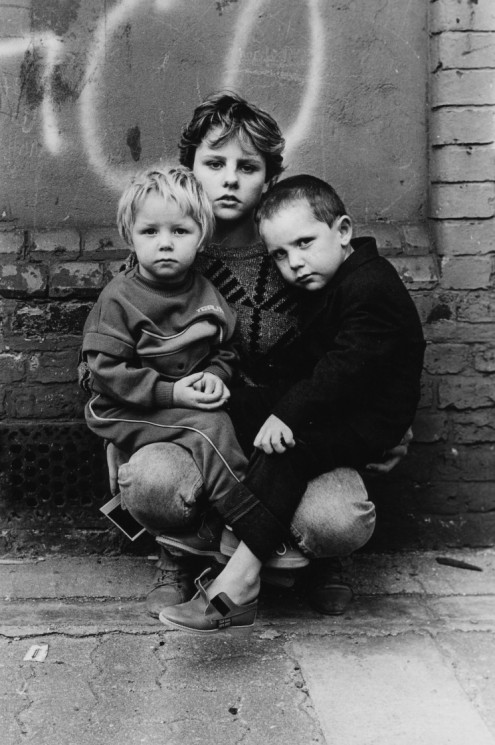
The cover photo for Colin’s “Travellers’ Children in London Fields”, 1987 – ‘I took many pictures over a period of three weeks and they took me into their confidence. It was only when I started to print the images that I realised what an amazing set of photographs they were.’
Making no big deal about it is not a bad way of summing up Colin’s approach to his work. He’s certainly made no big deal about it in terms of money, though he is entirely without bitterness on that account. ‘When I was starting out,’ he says, ‘there were two routes open to you if you wanted to make it big as a photographer. You could become a war photographer, as Don McCullin did, but I was too scared to do that; or you could do a David Bailey and become a celebrity photographer – but I just wasn’t interested in that world.’ In fact, Colin never became a photographer as such, not in the professional sense. All his photography was done in the margins of his working life, which was spent as a media resources technician for the ILEA and the GLC, and at the London College of Printing. For two hours or so every day, though, he would walk the streets with his camera, taking photographs of people who interested him.
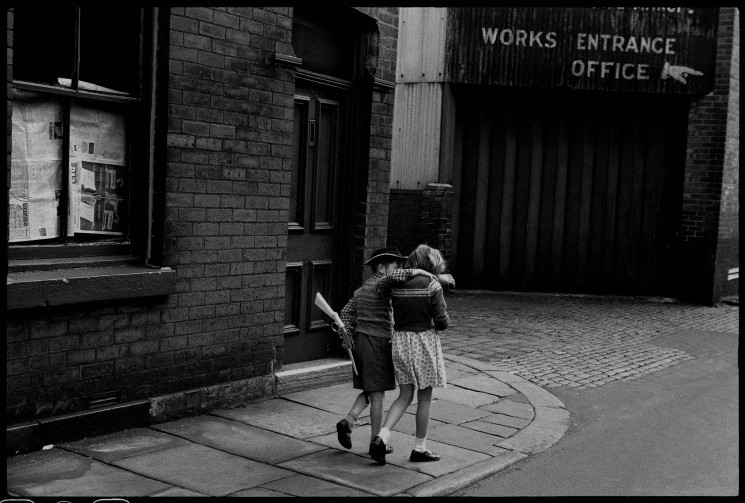
Cowboy and Girlfriend, Bolton, 1960 – ’Because I kept very bad records in the old days I thought that the picture had been taken in London, but a very nice lady wrote to me and told me that it was taken in Bolton. She named the very street, long since been demolished – she said Bolton was now a mess! It has probably been one of my most liked images.‘
He’s been taking photographs almost all his life. His Uncle Will gave him a box camera when Colin was eight years old (one of the photographs he took with this camera is in 100 Images: ‘Raymond Scallione and Joe Bacuzzi’, two boys posing with Italian magnificence on the bonnet of a black Ford in 1948), he had a Leica at the age of 14, has had more than 30 exhibitions in the course of his lifetime and is still – now well into his 70s – taking photos, both digital and film, and processing and printing his work in the traditional way in a darkroom.
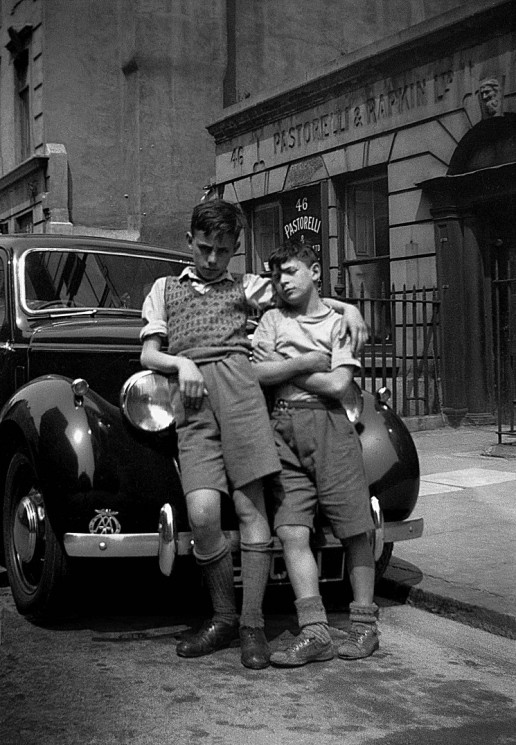
Hatton Garden, 1948 – ‘Raymond Scallione and his friend, Joe Bacuzzi, pose for me in this photograph taken when I was eight years old.’
In theory he’s retired but he has provided the photographs to more than 50 of the famous Spitalfields Life blog, he has just completed a new exhibition called London Life (beautifully recreated in a book published by Spitalfields Life and available on their site) and he has a new project lined up, on West End life, which he is undertaking with a young photographer, Alex Pink. You get the impression that Colin is not putting the lens cap back on his camera any day soon.
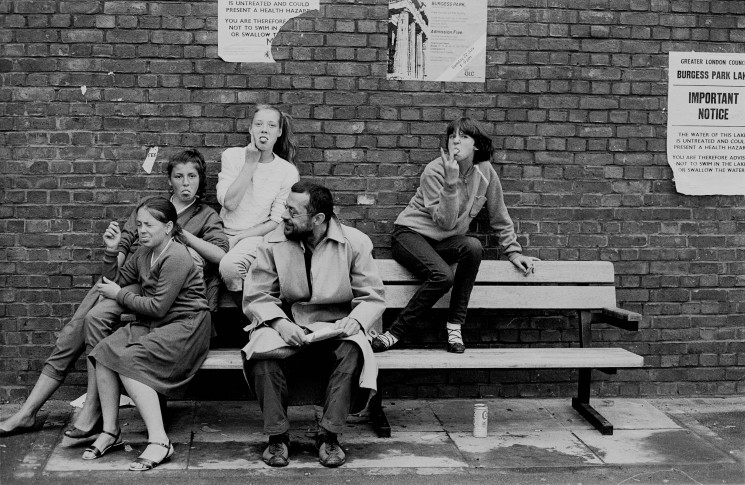
Burgess Park Lake, Old Kent Road, 1984 – ‘I’d photographed these girls before. They sat on a bench beside this man who had been following them around and, when I raised my camera again, each of them pulled a funny face and poked their tongues out.’
Brief snippets of his life emerge in the course of our talk. Although he has no trace of an Irish accent (apparently one emerged somewhat unexpectedly, and to the great amusement of his friends, in the course of an interview on the Robert Elms radio show), he is proud to describe himself as of Irish extraction, his grandparents having moved to England from Ireland in the late 19th century. His childhood was spent in London during what he calls the ‘threadbare years’, the last years of the war and the half-decade that followed. His adolescence was mostly playing football in the park with an impressive roster of future writers (Bill Naughton, Frederic Raphael and Brian Glanville among them), and he celebrated narrowly missing out on national service by ‘bumming around’ in his 20s. He had the opportunity to photograph the Beatles before they were famous (he used to take photographs for Dick James, the music publisher who took over Northern Songs) but turned it down, because he was too busy – or maybe, I wonder, because he had a foretaste of their future fame, and wasn’t interested. And all the time he was doing what inspired him, the real job his 9 to 5 job allowed him the time and space to do (when he wasn’t studying for a degree and a masters): taking pictures on the streets of London, capturing the passing scene of an ever-changing city.
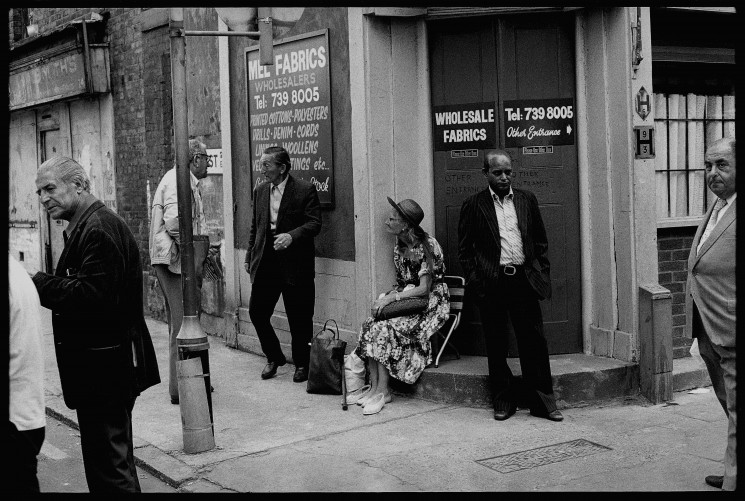
Comings and Goings, 1986 – Corner of Bacon Street and Brick Lane, Spitalfields
It’s clearly not the money that motivates him. Most of his exhibitions and publications he has paid for himself. And he’s not, as we’ve seen, interested in fame. His photography is an act of kinship similar to his involvement in community projects and campaigns such as the fight to save the Marquis of Lansdowne or the attempt to prevent the development of Norton Folgate. Something similar motivates him to continue taking his camera out on the street – an insatiable curiosity for, and an empathetic engagement in, other people’s lives. I’m guessing here, because this grandiose kind of phrase isn’t likely to be what Colin would say. His account would be something along the lines of ‘I just like people’, and maybe it is just that. Certainly there appears to be no distance, literally and metaphorically, between Colin and his subjects: his photos are imbued with a rare warmth and generosity.
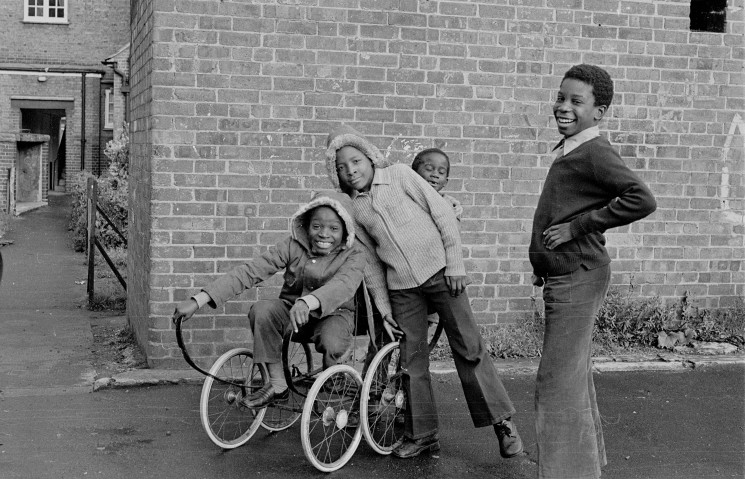
Wandsworth, 1973 – ‘These boys knew how to make good use of old pram wheels!’
Ah yes, that generosity. The books he’s brought with him are for me – an act of unassuming kindness on his part that touches me deeply. When I am flicking through the books later, making notes for this blog and trying to work out why his images have such emotional heft, it is this I come back to: his generosity, his engagement in other people’s lives, his sense that nothing divides us – we are all in this together.
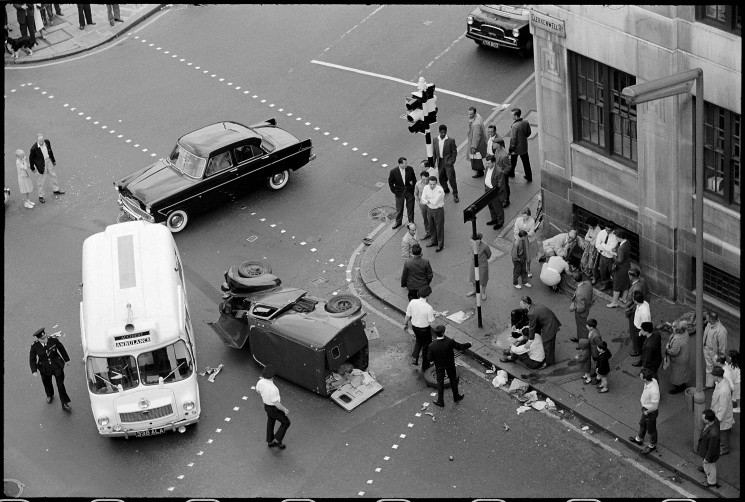
Junction of Clerkenwell Road and Farringdon Road, 11 June 1962 – ‘I read later that a child died in this accident. There was a rumour that the traffic lights malfunctioned, and all turned green at the same time.’
Colin O’Brien’s photos can be viewed on his website, colinobrien.co.uk. His latest book, London Life, is published by Spitalfields Life Books and is available from all good bookstores and on the Spitalfields Life site.
26 March, 2019
























